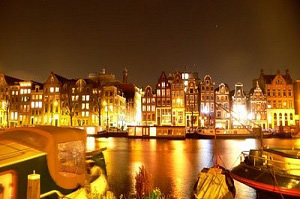
Amsterdam Guide
Amsterdam is a popular destination for everyone, young and old, budget or business traveller. Spend your days in-between canals and coffee shops, visit the Anne Frank House and the Heineken Experience, take a walk through the Vondelpark or rent a water bike, there is enough variation! Citybreak Amsterdam is happy to offer you some advice for a perfect holiday.
Amsterdam for everyone
Amsterdam is quite a compact city. Most tourist destinations are located in the centre, the canal-cut area from the main train station to Museumplein. The Dam, the principle square of the city, is a good starting point for a coffee or a breakfast before you start your day. The square offers some of the attractions as Madame Tussauds and the Royal Palace, but is also a great departure for a nice walk around the canals of Jordaan. You might include a visit to the Anne Frank House and take another coffee or lunch in a restaurant or café in the surrounding streets. Later on the day, cross Dam square another time to pay a visit to the area for which Amsterdam, and possibly the Netherlands as a whole, is most famous: the Red Light District, where you will be able to certify whether everything you heard about the area is true. To tell you a secret: it probably is! Next to Dam, Leidseplein is the second important location. From this square, the famous museums of Museumplein and the shopping areas of PC Hooftstraat, Leidsestraat and Kalverstraat are in walking distance. At night, Leidseplein’s many cafes, clubs and theatres will entertain you. What about a visit to a comedy show in Boom Chicago or a glass of whisk(e)y in the whisky cafe L&B?
Although Amsterdam is most popular under young people, coming for its famous temptations, also families and more traditional visitors will surely have a good time in the city. The charm of the canals earned Amsterdam the well-deserved title of Venice of the North. The city offers fine museums as Rijksmuseum and van Goghmuseum and wonderful markets. Children will definitely like a tour by boat or (water) bike, a visit to the magnificent Artis Zoo or the stimulating NEMO science museum. After your visit, for sure you will proudly say: I Amsterdam!
History of Amsterdam
The name Amsterdam originates from the old Aemstelledam, which was first mentioned in the year 1275, when the inhabitants of this village of fishermen received exemption from tolls. The name simply refers to a dam in the river Amstel, which crosses what currently is the eastern part of the city centre. The town expanded over the years, with houses mostly build in wood. Of these houses, two are still existing, the Houten Huis (Wooden House) at Begijnhof 34 and ‘t Aepjen (The Little Monkey) at Zeedijk 1. Other old buildings include the Oude Kerk (Old Church, Oudekerksplein 23) and the Nieuwe Kerk (New Church, Dam). Both churches currently host exhibitions. For example, the famous World Press Photo exhibition always kicks off in the Oude Kerk.
By the end of the 16th century, the Netherlands were fighting their liberation war against Spain. After the Spanish had conquered Antwerp (in current Belgium), Amsterdam took over the position of the most important harbour and trade market in the Netherlands and worldwide. In these years, ships of the Verenigde Oost-Indische Compagnie (VOC; United East Indian Company) sailed away to make money with spices from Indonesia, slaves from Ghana, and tobacco from New Amsterdam (the current New York). The central canals and the town hall at Dam, now the Royal Palace, date back to this time. The Golden Age of Amsterdam came to end in 1672, when the Netherlands was at war with four different enemies.
Although Amsterdam had lost its leading position, many classic houses in the centre originate from the late 17th or 18th century, such as the Willet-Holthuysen house, now a museum. Amsterdam lost its dominance in the years between 1795 and 1813, when the Netherlands were conquered by the French under Napoleon. Since the establishment of the first Kingdom of the Netherlands, The Hague has been the location of the government and the residence of the royal family. Nevertheless, Amsterdam has kept the status of titular capital. The nineteenth century was an age of great expansion, resulting in popular neighbourhoods’ as Jordaan and de Pijp. In the more rich Oud Zuid, the Vondelpark and the Concert Hall were designed. Current Amsterdam and its canal-cut centre are the home of the Dutch cultural and artistic elite. With its 800,000 inhabitants, it is a small and cosy European capital.
